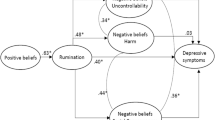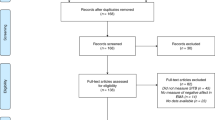Abstract
The present study examined the causal effect of negative mood on the deployment of as-many-as-can (AMAC) checking stop rules and compulsions. Participants underwent a negative or positive mood induction and subsequently completed self-report measures of AMAC checking stop rules and compulsions. The negative mood group scored significantly higher on both measures. As hypothesised, the direct causal effect of negative mood on compulsions was fully mediated by AMAC stop rules, with negative mood having a significant indirect effect on compulsions through AMAC stop rules. However, an alternative mediation model also showed that the direct causal effect of negative mood on AMAC stop rules was fully mediated by compulsions, with negative mood having a significant indirect effect on AMAC stop rules through compulsions. The implications of these findings for the understanding of the relationships between negative mood, AMAC stop rules and clinically relevant perseverative behaviours is discussed.


Similar content being viewed by others
References
American Psychiatric Association. (2013). Diagnostic and statistical manual of mental disorders (5th ed.). American Psychiatric Association.
Ball, S. G., Baer, L., & Otto, M. W. (1996). Symptom subtypes of obsessive–compulsive disorder in behavioural treatment studies: A quantitative review. Behaviour Research and Therapy, 34, 47–51.
Baron, R. M., & Kenny, D. A. (1986). The moderator-mediator variable distinction in social psychological research: Conceptual, strategic and statistical considerations. Journal of Personality and Social Psychology, 51, 1173–1182.
Britton, G. I. (2011). The relationship between causal constructs related to obsessive-compulsive disorder (Doctoral Thesis, University of Sussex). Retrieved from: http://sro.sussex.ac.uk/40521/1/Britton%2C_Gary_Ian.pdf
Britton, G. I., & Davey, G. C. L. (2014). Interrelationships between negative mood and clinical constructs: A motivational systems approach. Frontiers in Psychology, 5, 393.
Britton, G. I., & Davey, G. C. L. (2017). Negative mood and obsessive-compulsive related clinical constructs: An examination of underlying factors. Frontiers in Psychology, 8, 1570.
Campbell, D. T. (1957). Factors relevant to the validity of experiments in natural settings. Psychological Bulletin, 54, 297–312.
Cervone, D., Kopp, D. A., Schaumann, L., & Scott, W. D. (1994). Mood, self-efficacy, and higher performance standards: Lower moods induce higher standards of performance. Journal of Personality and Social Psychology, 67, 499–512.
Chan, J. C., Davey, G. C. L., & Brewin, C. R. (2013). Understanding depressive rumination from a mood-as-input perspective: Effects of stop-rule manipulation. Behaviour Research Therapy, 51, 300–306.
Clark, D., Antony, M. M., Beck, A. T., Swinson, R. P., & Steer, R. A. (2005). Screening for obsessive and compulsive symptoms: Validation of the Clark-Beck Obsessive Compulsive Inventory. Psychology Assessment, 17, 132–143.
Dash, S. R., & Davey, G. C. L. (2012). An experimental investigation of the role of negative mood in worry: The role of appraisals that facilitate systematic information processing. Journal of Behavior Therapy and Experimental Psychiatry, 43, 823–831.
Dash, S. R., Meeten, F., Jones, F. W., & Davey, G. C. L. (2015). Evaluation of a brief 4-session psychoeducation procedure for high worriers based on the mood-as-input hypothesis. Journal of Behavior Therapy and Experimental Psychiatry, 46, 126–132.
Davey, G. C. L., Eldridge, F., Drost, J., & MacDonald, B. (2007). What ends a worry bout? An analysis of changes in mood and stop rule use during a catastrophizing task. Behaviour Research & Therapy, 45, 1231–1243.
Davey, G. C. L., & Meeten, F. (2016). The perseverative worry bout: A review of cognitive, affective and motivational factors that contribute to worry perseveration. Biological Psychology, 121, 233–243.
Davey, G. C. L., Startup, H. M., Zara, A., MacDonald, C. B., & Field, A. P. (2003). The perseveration of checking thoughts and mood-as-input hypothesis. Journal of Behavior Therapy and Experimental Psychiatry, 34, 141–160.
Forgas, J. P. (2007). When sad is better than happy: Negative affect can improve the quality and effectiveness of persuasive messages and social influence strategies. Journal of Experimental Social Psychology, 43, 513–528.
Fritz, M. S., & MacKinnon, D. P. (2007). Required sample size to detect the mediated effect. Psychological Science, 18, 233–239.
Frost, R. O., Sher, K. J., & Geen, T. (1986). Psychopathology and personality characteristics of nonclinical compulsive checkers. Behaviour Research and Therapy, 24, 133–143.
Frost, R. O., & Steketee, G. (Eds.). (2002). Cognitive approaches to obsessions and compulsions: Theory, assessment, and treatment. Pergamon.
Gross, J. J., & Levenson, R. W. (1995). Emotion elicitation using films. Cognition and Emotion, 9, 87–108.
Haslam, N., Williams, B. J., Kyrios, M., McKay, D., & Taylor, S. (2005). Subtyping obsessive-compulsive disorder: A taxometric analysis. Behaviour Therapy, 36, 381–391.
Hawksley, J., & Davey, G. C. L. (2010). Mood-as-input and depressive rumination. Behaviour Research and Therapy, 48, 134–140.
Horowitz, M. J. (1985). Intrusive and repetitive thoughts after experimental stress. Archives of General Psychiatry, 32, 1457–1463.
Kline, R. B. (2005). Principles and practice of structural equation modeling (2nd ed.). Guilford.
MacDonald, C. B., & Davey, G. C. L. (2005). A mood-as-input account of perseverative checking: The relationship between stop rules, mood and confidence in having checked successfully. Behaviour Research and Therapy, 43, 69–91.
Martin, L. L., & Davies, B. (1998). Beyond hedonism and associationism: A configural view of the role of affect in evaluation, processing, and self-regulation. Motivation and Emotion, 22, 33–51.
Martin, L. L., Ward, D. W., Achee, J. W., & Wyer, R. S. (1993). Mood as input—People have to interpret the motivational implications of their moods. Journal of Personality and Social Psychology, 64, 317–326.
Meeten, F., & Davey, G. C. L. (2011). Mood-as-input hypothesis and perseverative psychopathologies. Clinical Psychology Review, 31, 1259–1275.
Meeten, F., & Davey, G. C. L. (2012). Mood as input and perseverative worrying following the induction of discrete negative moods. Behaviour Therapy, 43, 393–406.
Moore, K. A., & Howell, J. (2017). Yes: The symptoms of OCD and depression are discrete and not exclusively negative affectivity. Frontiers in Psychology, 8, 753.
Rasmussen, S. A., & Tsuang, M. T. (1986). Clinical characteristics and family history in DSM-III obsessive-compulsive disorder. American Journal of Psychiatry, 143, 317–322.
Roper, G., & Rachman, S. (1976). Obsessional-compulsive checking: Experimental replication and development. Behaviour Research and Therapy, 14, 25–32.
Rottenberg, J., Ray, R. D., & Gross, J. J. (2007). Emotion elicitation using films. In J. A. Coan & J. B. B. Allen (Eds.), Handbook of emotion elicitation and assessment (pp. 9–28). Oxford University Press.
Salkovskis, P. M. (1985). Obsessional-compulsive problems: A cognitive-behavioral analysis. Behaviour Research and Therapy, 16, 233–248.
Scott, W. D., & Cervone, D. (2002). The impact of negative affect on performance standards: Evidence for an affect-as-information mechanism. Cognitive Therapy and Research, 26, 19–37.
Siedlecka, E., & Denson, T. F. (2019). Experimental methods for inducing basic emotions: A qualitative review. Emotion Review, 11, 87–97.
Startup, H. M., & Davey, G. C. L. (2001). Mood as input and catastrophic worrying. Journal of Abnormal Psychology, 110, 83–96.
Summerfeldt, L., Antony, M. M., Downie, F., Richter, M. A., & Swinson, R. P. (1997). Prevalence of particular obsessions and compulsions in a clinic sample. In R. P. Swinson, M. M. Antony, S. Rachman, & M. A. Richter (Eds.), Obsessive compulsive disorder: Theory, research, and treatment (pp. 3–32). Guilford Press.
Author information
Authors and Affiliations
Contributions
Both authors contributed to the study conception and design. Material preparation, data collection and analysis were performed by Gary Britton. The first draft, and the revised draft, of the manuscript was written by Gary Britton, and both authors worked on previous versions of the manuscript. Both authors have approved the final manuscript.
Corresponding author
Ethics declarations
Ethical Approval
All procedures performed in studies involving human participants were in accordance with the ethical standards of the institutional and national research committee and with the 1964 Helsinki declaration and its later amendments or comparable ethical standards. This article does not contain any studies with animals performed by any of the authors.
Informed Consent
Informed consent was obtained from all individual participants included in the study.
Conflict of Interest
The authors declare no competing interests.
Additional information
Publisher's Note
Springer Nature remains neutral with regard to jurisdictional claims in published maps and institutional affiliations.
Rights and permissions
About this article
Cite this article
Britton, G.I., Davey, G.C.L. An Experimental Investigation of the Effect of Negative Mood on the Deployment of As-Many-As-Can Checking Stop Rules and Compulsions. J Cogn Ther 15, 153–167 (2022). https://doi.org/10.1007/s41811-022-00134-0
Accepted:
Published:
Issue Date:
DOI: https://doi.org/10.1007/s41811-022-00134-0




